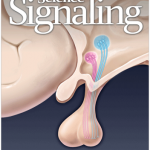
I feel like I've seen this movie before. A group of thieves need to gain entry to a highly secured vault. The vault door is nearly impregnable, and once inside, there are motion sensors, security cameras and laser trip lines, all of which sound the alarm. When the security guards hear what's happening, they are told to release a deadly gas into the vault, killing anyone inside. But Salmonella enterica, that charming bug responsible for all manner of unpleasantness, is a clever burglar. It has learned to live inside macrophages - cells that are usually used to destroy bugs - and uses their own…
I've been to Washington DC on a number of occasions, but this was a totally new experience. Starting at 10am, I had a meeting every hour on the hour with congressional staff, and I asked them all the same thing: Don't cut the budget of the NIH.
You may know that the government is struggling to keep itself funded. Last year, the Democrats punted the obligation of passing a budget for FY2011 to the next congress, and since the new Republican majority in the House has taken power, no one can agree on anything. The first bill out of the new House (HR1), was a spending bill that made huge cuts to…
Tomorrow, as part of the @ASBMB "Hill Day," I'm headed to capitol hill to meet with my congressman and my senators (or more likely their staff) in order to plead for science funding. If you pay any attention to politics, you know that congress has been locked in budget battles for months, and since government grants account for the vast majority of basic science research have a pretty large stake in this fight.
One Republican proposal out of the house (that was defeated in the senate) cut over $1 billion of NIH spending. I doubt this is out of malice, but when trying to reduce spending when…
For those of you don't already have some affliction (facebook, reddit etc) that sucks up all the time you should really be working, try:
The Power of Research!
I didn't get very far, but only because I have real lab work to do. It seems silly to procrastinate by doing a virtual research project. It seems like a cool idea though - anything to get the general publish* public to sympathize with researchers is a plus in my book.
Let me know how it goes (also... if you choose immunology as a specialty, one of the options is a TLR research project, I must approve).
*Freudian Slip?
I saw this link on a friend's facebook page, and left that tab open in my browser for a while, intending to write a post on it.
Professor Charles Gerba, the lead researcher, swabbed the handles of 85 carts in four states for bacterial contamination.
Gerba says 72% of the carts had a positive marker for fecal bacteria. When they examined some of the samples, they found Escherichia coli, also known as E. coli, on half of them.
I just couldn't muster the energy. Thankfully, Mike the Mad Biologist took care of this one.
both S. aureus and E. coli are commensal organisms: they live on and in us,…
... because I love science and I love beer, obviously.
I had a great time moderating Science by The Pint last night! It is always awesome to be reminded how enthusiastic non-scientists often are about science. I find events like this incredibly refreshing when I have been stuck in a science rut or simply less enthusiastic about my work than usual.
I had participated in one of these events last year, when an upper level grad student was speaking. I wandered from table to table talking about how cool hydrothermal vents are, and why we think its important to study them. People asked…
Those of you living in Bosto-Camber-ville* might be interested in attending tonight's Science by the Pint. Our featured speaker is Alex Bradley - the author of the guest post critiquing the Arsenic paper a while back. Come to Tavern in the Square - Porter Square tonight, March 8 at 7pm to chat with Alex and his colleagues about microbially-catalyzed biogeochemical cycles and the coevolution of life and Earth. Yours truly will be hosting, and it will be awesome.
Cheers!
* Boston, Cambridge, or Somerville, MA
One of my earliest memories is of waves. I was 7 or 8 years old, on some nameless stretch of sand in southern California, and I was trapped. I don't remember when I learned to swim, and I don't remember a time when I didn't love the ocean. But I remember the day I learned to respect it.
My brother Steve and his friend Chris were already back on the beach, but I don't remember why I hadn't followed them. Maybe I had something to prove; they were 3 years older and teased me incessantly, so I was always trying to show them that I could be tough. Maybe I meant to follow them, but couldn't swim…
Check out this explanation in the New York Times science section of the 5 second rule. For the record, this will not stop me from eating fallen food off the floor. But that's just now I roll.
I started writing a lengthy response to a reader comment on one of Heather's posts, but decided it could use a post of it's own.
The question:
As to being pathogenic, is it possible that many bacteria are pathogenic if given sufficient opportunity?
[snip]
It seems largely to me that the line between pathogenic and non-pathogenic is pretty blurry.
Totally.
Let's get some definitions out of the way first - a pathogen is an organism that causes disease. That seems simple enough, but when you examine the real world more carefully, things turn complicated pretty fast. What do I call the cold I was…
If you were going to design the perfect immune system, what would you do? This question is often posed to beginning immunology students, and the best answer may be so obvious that it doesn't occur to most. The best immune system is one that prevent pathogens from ever gaining access to your squishy bits in the first place.
And so we have barriers - lots of them. Unfortunately, the best barriers are not always practical. Plants have rigid cell walls that are almost impervious to pathogens, but plants don't need to walk around. We trade that in for skin and that does pretty well, but it has…
I got to spend last week in sunny California. I forgot how wonderful it is to sit and eat lunch outside! I was participating in a workshop held at the Department of Energy's Joint Genome Institute (JGI). The workshop was entitled Microbial Genomics and Metagenomics. Basically I spent the week learning about different tools that are available to help biologists deal with the data flood that has come out (and continues to flow faster and faster) of sequencing technologies that continue to get faster and cheaper.
Since microbes are not exactly easy to observe with ones eyes,…
I mentioned this study a while ago, and promised a more detailed explanation. I apologize for how long it has taken, but here it is.
How excited was I to learn that the most recent issue of Nature Geoscience had a special focus on deep sea carbon cycling? I admit it, pretty excited. I was even more excited to learn that one of the 3 papers making up this special focus was about the microbial component of deep sea carbon cycling. This may not be something that you think about every day, but I do... well most days at least. The first two sentences of this paper explain why I find this…
At the superbowl party at my house last weekend, most folks didn't really have a stake in who won. But several friends were rooting for Pittsburg to loose, largely due to their quarterback, Ben Roethlisberger. In case you don't pay attention to sports news (like me), Roethlisberger was twice accused of rape/sexual assault in the last two years. When folks were talking about it, I foolishly said something along the lines of, "well, what were the cirumstances of the rape?"
The Daily Show - Rape Victim Abortion FundingTags: Daily Show Full Episodes,Political Humor & Satire Blog,The Daily…
I was going to cover this paper, but Ed beat me to it (and did a far better job than I would have):
With a pulse of light, Dayu Lin from New York University can turn docile mice into violent fighters - it's Dr Jekyll's potion, delivered via fibre optic cable. The light activates a group of neurons in the mouse's brain that are involved in aggressive behaviour. As a result, the mouse attacks other males, females, and even inanimate objects.
Lin focused on a primitive part of the brain called the hypothalamus that keeps our basic bodily functions ticking over. It lords over body temperature,…
My common New Year's resolutions (get more exercise, keep my lab notebook up to date, etc) rarely make it off the starting block. In this I am hardly unique, and there are very good reasons why, so I usually also try to make one major, sort of intangible resolution. This year for instance (largely because of reading this book), I decided to try to be wrong more often. More precisely, I'm trying to want to change my mind.
It's hard to know how well this is going (with all of the things I'm not changing my mind about, it's obviously because I'm right), but alas, all my other resolutions have…
PalMD has a great post about vaginas. More specifically, about the wonderful commensal bacteria that help keep a vagina at the proper pH, and what happens when they get booted out:
From time to time, this normal balance of bacteria is disrupted. When this happens, the normally dominant Lactobacilli are outgrown by various anaerobic bacteria. These bacteria break down proteins in the vagina and create various malodorous compounds that are discharged in a thin, grey discharge. It is this symptom that normally drives a woman to the doctor where she is diagnosed with bacterial vaginosis (BV).…
Local announcement for folks in the Boston area:
Science by the Pint is back in full force for its second season at a new venue, the Tavern in the Square in Porter Square. Science by the Pint is SITN's own science cafe - a fun, informal event where scientists mingle with the general public to talk about their research, why they do it, and how it affects the world. Join us the second Tuesday of each month from 7-9pm.
In our next Science by the Pint, Elizabeth Thomas and her colleagues from Brown University will chat about their work studying climate change in the recent past and present. Join…
For your ammusement, I give you the latest Science Signaling cover:
According to the journal,
The image shows the AVP neurons, which have their cell bodies in the hypothalamus and nerve terminals in the pituitary.
Oh really? Someone must have hired the little mermaid guy.
I've said it before, and I'll say it again - pathogens are devious little bastards:
Discovery of a Viral NLR Homolog that Inhibits the Inflammasome
In order to respond to a virus, a cell first has to recognize that it's there. There are a lot of ways the cell tries to do this - some receptors (like the TLRs I study) look for features that are unique to pathogens that are outside the cell. Others look for molecules (like DNA and RNA) that are shared between us and pathogens, but are in the wrong place (DNA outside the nucleus is a pretty sure sign of infection).
NOD-like receptors (that's the…


